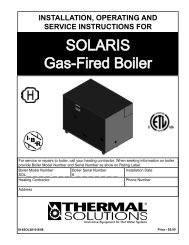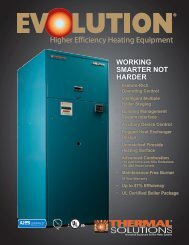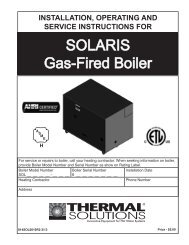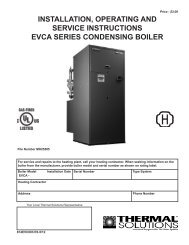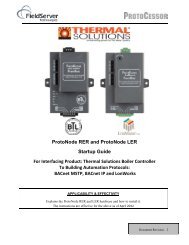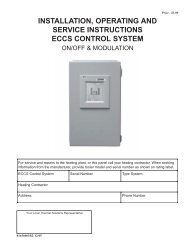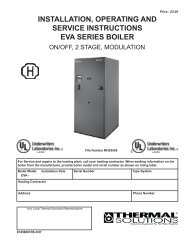I&O Manual - Solaris Water Heaters - Categories On Thermal ...
I&O Manual - Solaris Water Heaters - Categories On Thermal ...
I&O Manual - Solaris Water Heaters - Categories On Thermal ...
Create successful ePaper yourself
Turn your PDF publications into a flip-book with our unique Google optimized e-Paper software.
i. Addition of excessive make-up water as aresult of system leaks.ii. Absorption through open tanks and fittings.iii. Oxygen permeable materials in the distributionsystem.b. In order to insure long product life, oxygensources must be eliminated. This can be accomplishedby taking the following measures:i. Repairing system leaks to eliminate the needfor addition of make-up water.ii. Eliminating and/or repairing fittings whichallow oxygen absorption.iii. Using non-permeable materials in the distributionsystem.iv. Isolating the water heater from the systemwater by installing a heat exchanger.vi. Using properly designed and operating airelimination devices in water piping.3. Design and install system piping to prevent returnwater temperatures below 130°F. Refer to Table 2 forwater heater flow and pressure drop requirements.4. Connect system supply and return piping to waterheater. Refer to Figure 8. Also consult I=B=R Installationand Piping Guides. Maintain ½” minimumdistance between water piping and combustible material.Consult <strong>Thermal</strong> Solutions for unusual systemrequirements.CAUTIONReturn water temperature below 130°F will causeflue gas condensation inside the water heater.Flue gas condensate can lead to water heaterfailure. <strong>Thermal</strong> Solutions Standard Warrantydoes not cover problems caused by flue gascondensation.WARNINGSupply and return water temperature differencesgreater than 40°F can lead to water heater failure.<strong>Thermal</strong> Solutions Standard Warranty does notcover problems caused by temperaturedifferences greater than 40°F.5. A pressure relief valve is supplied with each appliance.No valve is to be placed between the reliefvalve and appliance. No reducing coupling or otherrestriction shall be installed in the discharge line.See Figure 13.a. Pipe the safety relief discharge to a suitable placefor disposal when relief occurs.b. Do not install reducing couplings for other restrictivedevices in the safety relief discharge line.c. The safety relief discharge line must allow forcomplete drainage of both the valve and line.6. If the relief valve discharges periodically, this maybe due to thermal expansion in a closed watersupply system. Contact the water supplier or localplumbing inspector on how to correct this situation.DO NOT PLUG THE RELIEF VALVE.7. Install the drain valve provided with the appliance atthe lowest elevation. See Figure 13.8. Install water flow switch. <strong>Water</strong> flow switch mustbe located such that water flow disruptions do notaffect switch operation. Maintain maximum practicalstraight piping before and after flow switch tominimize water disruptions. Refer to manufacturer’sinstructions for proper paddle length.9. A low water cutoff is required to protect a hot waterwater heater when any connected heat distributor(radiation) is installed below the top of the hot waterwater heater (i.e. baseboard on the same floor levelas the water heater). In addition, some jurisdictionsrequire the use of a LWCO with a hot water waterheater. If a low water cutoff is required, it mustbe mounted in the system piping above the waterheater. The minimum safe water level of a hot waterwater heater is just above the highest water containingcavity of the water heater; that is, a hot waterwater heater must be full of water to operate safely.10. Oil, grease, and other foreign materials whichaccumulate in new hot water water heaters and anew or reworked system should be boiled out, andthen thoroughly flushed. A local qualified watertreatment chemical specialist is a suggested sourcefor recommendations regarding appropriatechemical compounds and concentrations which arecompatible with local environmental regulations.11. After the water heater and system have been cleanedand flushed, and before refilling the entire systemadd appropriate water treatment chemicals, if necessary,to bring the pH between 8.8 and 9.2.12. If it is required to perform a long term pressuretest of the hydronic system, the water heater shouldfirst be isolated to avoid a pressure loss due to the21



